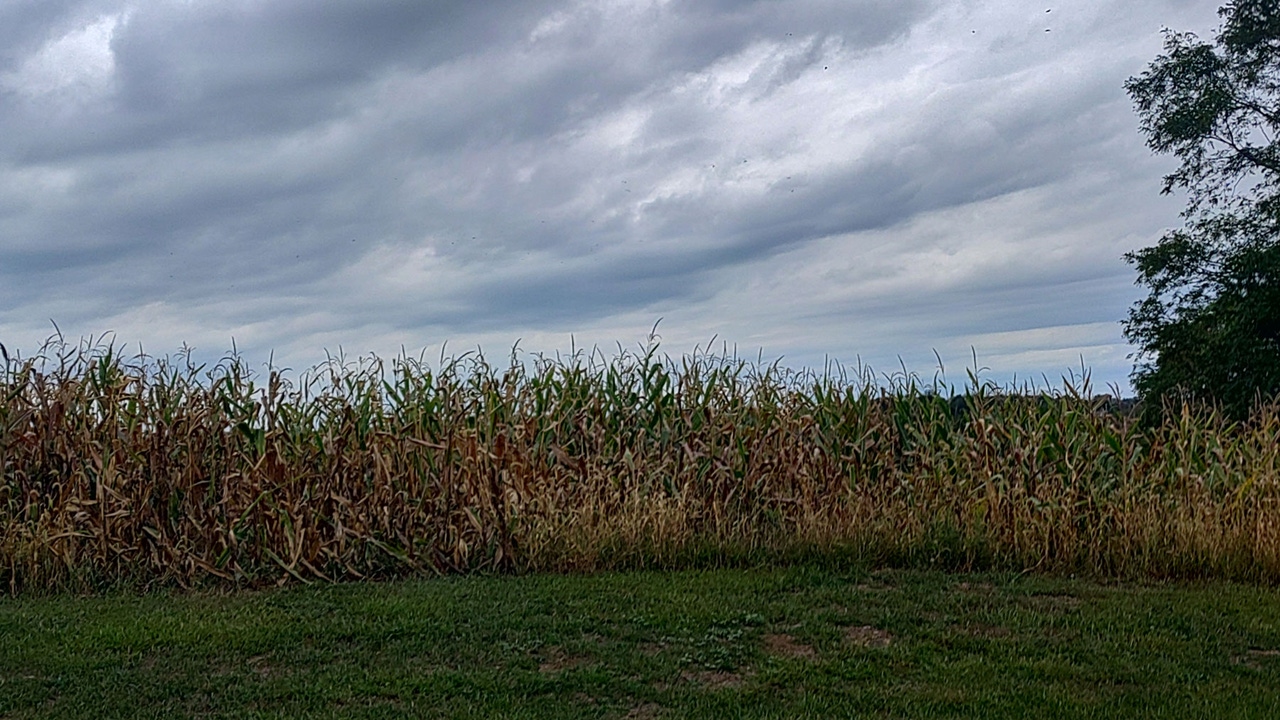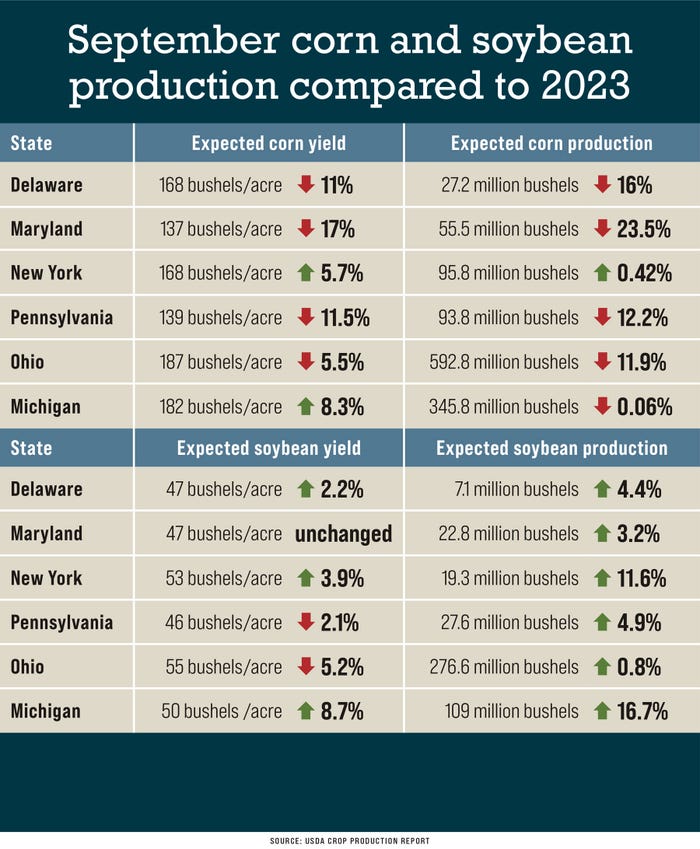
Corn yields are way down while soybeans are showing resilience.
Chris Torres, Editor, American Agriculturist

Much of the mid-Atlantic and Northeast was spared from severe drought, but there were more than enough hot, dry spells to wreak havoc on yields.
“We filed a crop insurance claim back at the end of August,” says Mike Reskovac, who farms more than 1,000 acres in Uniontown, Pa. “Our best-looking corn checks in at 140 bushels, and best beans should be around 40. With that said, there will be beans in the single digits and a few farms of sub-50-bushel corn yields as well. When you have a drought as well as high wildlife pressure, the crop tends to disappear in a hurry. Deer damage is really getting out of hand here.”
Reskovac co-owns Reskovac Farms, which includes 400 acres of corn, 450 acres of soybeans, and nearly 50 acres combined of wheat, sunflowers, hay, pumpkins and sweet corn.
The heat started in June, let up somewhat in August, but returned with a vengeance in September.
“September was almost as hot and dry as June and July,” Reskovac says. “There was not really any moisture there to finish out what crop we had. I have talked to a few guys that cut silage a week or two ago, and average yields were 5 to 10 tons per acre when they should have been 20 to 25 tons.”
Farther east, yields are better, but nothing earth-shattering.
Eric Rosenbaum, whose Rosetree Consulting Inc. works with 300-plus farms covering 75,000 acres in Pennsylvania, says most of his growers are just satisfied with that they have, considering how hot and dry it was at times.
Early data from growers he works with in Berks, Lancaster and Lebanon counties showed full-season soybean yields off 10-15 bushels an acre.
Corn silage was also off, too. But grain, as a percentage of total yield, has been better than expected.
“Lack of water is the biggest factor, but to be more focused, it was a lack of water during critical reproductive growth stages,” Rosenbaum says. “We were able to pollinate and set kernels for above-average yields, but could not hold onto kernels. The lack of rain in the 10- to 14-day period following pollination hurt the most. Same with beans. Drought and heat during flowering reduced our ability to retain pods. Late kernel-fill dry periods also reduced kernel size and test weight. It's hard to get a dense kernel [high test weight] when you don't have enough water in the plant to move nutrients and carbohydrates.”
Yields adjusted higher
The September USDA Crop Production Report shows corn yields adjusted higher from August in Delaware, Michigan, New York and Pennsylvania, but lower in Ohio.
Soybean yields have been adjusted higher for every state except Ohio.

Get ready for 2025
What’s Rosenbaum telling his growers during this time of low crop prices? Have a good plan on paper first, then execute.
“If every farm could spend more time calculating cost of production figures, assessing the profitability of each parcel farmed based on three-year yield averages,” he says. “Also, look at current financial positions and forecasted positions, and start to work on a 2025 marketing plan. After that is nailed down, then start looking at fertilizer and seed input needs, and what things you want to experiment with. Yes, you need a very sharp pencil for next year, but we also need to keep finding ways to push production.”
And don’t forget to purchase the right seed, coupled with a focus on soil health.
“There is a lot more drought tolerance built into today's genetics compared to 20 years ago,” Rosenbaum says. “Pennsylvania farms have also adopted many soil health practices that increase soil resiliency during dry periods. While the soil health thing is a long-term play, it does go hand in hand with immediate advances in genetics and fertility strategies that allow crops to attain ‘almost-average’ yields with less water.”
Reports from field
Bill Beam, owner of Beam Farms in Elverson, Pa., has harvested 400-plus acres of corn with yields averaging between 190 and 200 bushels an acre. He has harvested less than 100 acres of soybeans, but yields are averaging 60 bushels an acre.
“We are pleasantly surprised so far,” Beam says.
Donald Maring, owner of Donald Maring Farms in Woodbine, Md., recently started harvesting.
“Yields at home where I started were 150 to 160,” he says. “The first 90 acres planted pollinated during the hottest week with nighttime temps not going below 80, so pollination left a lot to be desired. Moisture is variable; 18% on the high side of the field and 27% to 28% in the lower areas. It’s averaging about 22%. Ear counts and visual scouting looks like the rest should run 200 bushels or a little better.
“Soybeans look good at this point. I had to replant 170 acres for slugs and 45 acres a third time. Most of the acres planted to shorter-maturity beans for early harvest to get wheat in were the ones replanted. Double-crop beans were planted by June 28, and are mid-thigh and look to have excellent potential.”
A little farther west, Gary Grossnickle, who farms more than 1,300 acres in Walkersville, Md., says his crops have struggled all season.
“Corn grain yields will be well below average,” he says. “Replanted over 10% of corn acreage because of slugs. July rainfall was almost nonexistent. Silage yields were OK; all the replanted corn was chopped for silage. Probably will have an insurance claim on corn.
“Soybeans look much better. Rainfall in August was very timely. Yields should be around our five-year average, even with replanting because of slugs.”
Larry Gervais, co-owner of Gervais Dairy Farm, a 3,200-acre dairy and crop farm in and around Enosburg, Vt., is surprised by the corn silage yields he’s seeing.
“Yields have been better than expected. The wet summer was making it look like we would be below average yields,” he says. “Overall yields of corn silage harvest have been coming back at around 21 tons per acre, which is slightly above our average yields. The starch levels have been surprisingly high, around 42. The last two weeks of hot, dry weather attributed the good starch level response.
“The biggest factor affecting yield was the above-average rainfall we received in our area throughout most of the summer,” he adds. “I did file a claim on one of our farm units. The clay soil and wet summer affected this farm unit the most, as yield was only around 11 tons an acre.”














